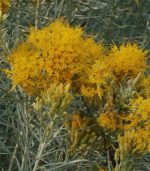 Rubber rabbitbrush is a deciduous shrub and a member of the aster family, Asteraceae, that also includes daisies, yarrow, and lettuce. It is naive to the western third of the US except the Pacific Northwest and grows in open sunny areas with dry soil. Plants can be found in disturbed sites, foothills, mountains, valley bottoms, plains, and high deserts, often associated with sagebrush. As the common name suggests the plant contains latex in its sap but not in quantities that make rubber production profitable.
Rubber rabbitbrush is a deciduous shrub and a member of the aster family, Asteraceae, that also includes daisies, yarrow, and lettuce. It is naive to the western third of the US except the Pacific Northwest and grows in open sunny areas with dry soil. Plants can be found in disturbed sites, foothills, mountains, valley bottoms, plains, and high deserts, often associated with sagebrush. As the common name suggests the plant contains latex in its sap but not in quantities that make rubber production profitable.
Description: Well branched plants grow four to eight feet tall and have stems that are covered with woolly gray, green, or white hairs that give off an unpleasant order when crushed. The narrow leaves are up to 2 3/4 inch long and are often woolly and foul smelling when bruised. The flower heads consist entirely of yellow tubular disc flowers and appear from mid summer into fall. The fruits are achenes with tufts at the tip. Plants spread by seed and resprouts from basal buds.
Control: Mulch, dig, or pull seedlings as they appear. Dig out larger plants before they set seed. Mowing and cutting tends to encourage sprouting and should be avoided. In severe cases herbicides such as 2,4-D and glyphosate may be used but are only moderately successful. Apply in mid to late spring when new growth is about two to three inches long.